Early detection of Parkinson’s disease by machine learning techniques using artificial intelligence (AI) methods. The author of this article is a joint researcher and a Master of Science in Computer Science, USA, with the help of India’s one of the best neuro physician doctors, who has been honoured and awarded the “PADMA SHRI,” the fourth-highest civilian award in the Republic of India.
Machine Learning Process: Machine learning models are statistical models that take inspiration from brain cells called neurons. Artificial Neural Network (ANN) can mathematically model how the biological brain works, allowing the machine to mimic the human brain.
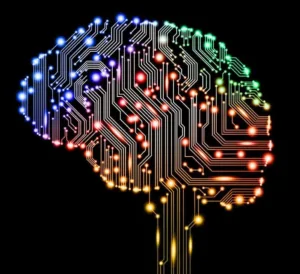

Parkinson’s Disease Founder: James Parkinson FGS (11 April 1755 – 21 December 1824) was an English surgeon, apothecary, geologist, and paleontologist who was the first to describe a neurological disorder called ‘paralysis agitation’ or ‘the shaking palsy’ in 1817.

Abstract: Parkinson’s disease (PD) has been considered a mission for mankind for several decades. Its detection with the help of an automated system is a subject undergoing intense study. This entails incorporating a machine-learning model for the PD.
To discover a foolproof model, the cardinal prerequisite is to study the existing computationally intelligent techniques in the field of research used for the early detection of Parkinson’s disease. Many existing models focus on singular modalities or have a cursory analysis of multiple modalities.
We conducted a comparative literature study on the four main modalities used for early detection of Parkinson’s disease, which include tremor at rest, bradykinesia, rigidity, and voice impairment. Our aim was to encourage the early detection of the disease. In order to accomplish our goal, we utilized a range of advanced machine learning techniques on multiple modalities, including Logistic Regression (LR), Support Vector Machine (SVM), Decision Tree (DT), K-nearest neighbors (KNN), Stochastic Gradient Descent (SGD), and Gaussian Naive Bayes (GNB). Each modality was trained on its respective dataset.
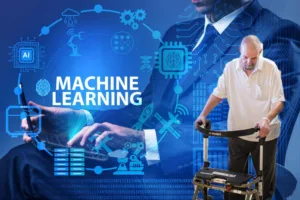
Furthermore, ensemble approaches such as Random Forest Classifier (RF), Adaptive Boosting (AB) and Hard Voting (HV) are implemented. Our results are compared with those obtained with their respective research. Among all the tests, applying Random Forest (RF) to the Static Spiral Test (for detecting tremors) gave us the most significant result in PD, i.e., the highest accuracy of 99.79%.
This leads to the conclusion that the multi-modal approach, with the help of the ensemble method, should be used to get better and more accurate results. Hence, taking the help of ML and AI for the early detection of Parkinson’s disease is the greatness of science.
Parkinson’s has four main symptoms:
- Bradykinesia/slowness of movement
- Tremor in hands, arms, legs, jaw, or head
- Rigidity: muscle stiffness, where muscle remains contracted for a long time
- Voice-impaired balance and coordination
Parkinson’s disease (PD) is a long-term neurological disorder that causes a person to lose control over several body functions, including speech. It is the second most common neurodegenerative disease after Alzheimer’s disease. The loss of nerve cells in the part of the brain called the substantia nigra causes PD. These nerve cells, or neurons, create an organic chemical named dopamine, which acts as a neurotransmitter between the parts of the brain and central nervous system that helps to control and coordinate body movements.
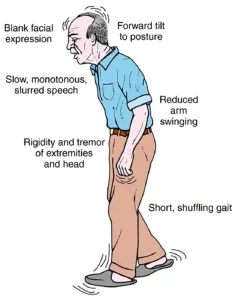
Although this disease can be diagnosed at an early stage,. But with the advent of strong tools like artificial intelligence and machine learning, this took a subtle turn; various state-of-the-art machine learning tools and techniques analyzed the high dimensions of data in the datasets, which made the work of prediction simple. Now, it is highly necessary for the early detection of Parkinson’s disease and its remedy.
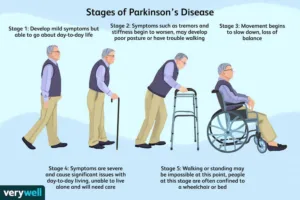

Bradykinesia: Bradykinesia, or slowness of movement, is one of the major symptoms of PD. It results from a failure of basal ganglia output to reinforce the cortical mechanisms that develop and execute the motor system commands, which results in motion. The reduced dopaminergic substances in the striatum may result in increased neuronal firing, which hinders basal ganglia output. Due to this deficiency, the person starts to experience abnormal movement activities, which results in difficulty with self-paced motions.
There are several techniques and analyses available to detect bradykinesia. Data mining techniques and their applications are widely used to address this cause. Along with it, a new technology called ‘Leap Motion’ aimed at detecting bradykinesia with ease.

Tremor at rest: Tremor is a rhythmical and involuntary oscillatory movement of the body parts. It is a symptom of various diseases. There are some peculiar characteristics by which early detection of Parkinson’s disease-affected tremors is identified. PD patients have a higher incidence of tremors in the hands compared to other body parts.
One of the major diagnostic features is the suppression of rest tremors during movement initiation. These studies prove that tremor-dominant PD is a distinct subtype that can help in the early detection of PD. Tremor at rest is a wide field of research,, and various techniques help detect it.

Rigidity: is one of the four major symptoms for the early detection of Parkinson’s disease. It refers to the abnormal stiffness in the limbs or other body parts that prevents muscles from stretching or relaxing. It can occur on one or both sides of the body. Characteristics of Rigidity are stiffness in muscles, like facial muscles. Disability to display countenance and not be able to enunciate fluently paved the way for speech therapy.
It is treated with medications like levodopa and various inhibitors, namely, catechol-O-methyltransferase (COMT) and monoamine oxidase-B (MAO-B) inhibitors. Physiotherapy is also administered to pacify the excruciating effects of the disease. As the disease progresses, the day-to-day tasks become more difficult. Hence, specialists perform occupational therapy to ameliorate their effects.

Voice Impairment: Whether or not to consider voice impairment in the early detection of PD is a debate that has been going on for many years. Many renowned neurologists do not consider this symptom as an early sign of PD. Some adamantly argue that vocal symptoms are the most prominent ones at an early stage, along with tremors and rigidity,. An intermittent solution is provided in that voice impairment can be described as early detection of Parkinson’s disease, and there is conclusive evidence of the late appearance of dysarthria in PD patients.
PD causes damage to the nerves, which affects the central nervous system while simultaneously deteriorating the substantia nigra and pars compacta. This results in limiting the secretion of dopamine, which helps to produce smooth muscle movement, affecting the affected person’s facial muscles and countenance.
Research:
Early detection of Parkinson’s disease includes all aspects, such as biological, chemical, and genetic. Gradually, some of them evolved by applying machine learning and artificial social intelligence, which contributed to the early detection of this disease. PD is a diagnostic disease and there is no confirmed symptom or guaranteed detection technique, There are many people who have given their best shot at early detection Parkinson’s Disease and prevention of this disease.
Results and Discussion:
For early detection of Parkinson’s disease, all the machine learning algorithms are compared based on specificity and sensitivity. The terms sensitivity and specificity are used to denote the ability to predict the probability of actual positive trials and negative trials, respectively. These terms can be seen in the results presented in Figures 2 to 7. To improve the accuracy, three ensemble approaches, namely, RF (bagging method), AB (boosting method), and HV (voting method) were implemented along with the algorithms in all four modalities.
![]()
Bradykinesia: Various machine learning algorithms have been implemented to understand the symptoms and extract useful features from the data. The dataset used is taken from the UCI repository. The algorithm results are listed in Fig. 2. The implementation of RF and HV technology has resulted in a high accuracy rate of 97.5%. The first sign of early detection of Parkinson’s disease.

Tremor at rest: Various machine learning models shown in the figure are applied, and many of them resulted in higher accuracy compared to previous studies that used the dataset from the UCI repository. The figures illustrate that the Random Forest algorithm achieved the highest accuracy rates in SST, DST, and STCP with 99.79%, 99.76%, and 99.71%, respectively. This clearly helps with the early detection of Parkinson’s disease.
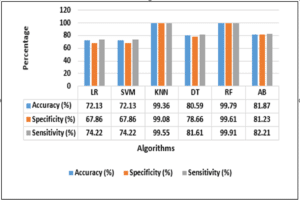
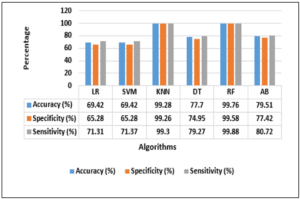
Rigidity: To understand the significance of gait analysis for rigidity detection, PhysioNet’s Gait Database is implemented. Pre-processed the data, extracted the features, and implemented various state-of-the-art machine learning algorithms. The highest accuracy was 83.12% in Random Forest Classifier and Adaptive Boosting, as shown in Fig. 6. Signs of early detection of Parkinson’s disease.

Voice Impairment: A Major Roll for Early Detection of Parkinson’s Disease. The dataset of the UCI repository is used, which consists of the data of 31 people (23 PD-affected patients and 8 healthy subjects). Various machine learning algorithms are implemented for the classification of the disease, and the results are shown in Fig. 7 show a maximum accuracy of 97.96% by implementing KNN on the same dataset.
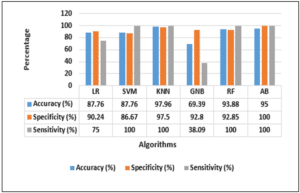
Parkinson’s walking Tips:
Also read: The Latest Painless Hair Transplant Therapy & Cost.
